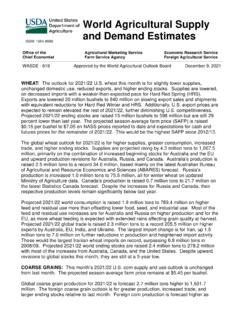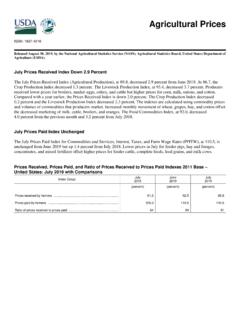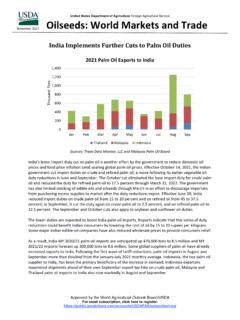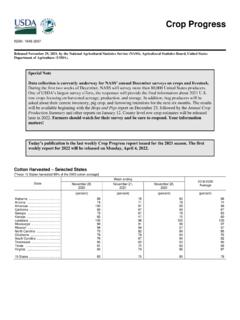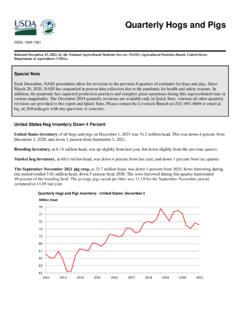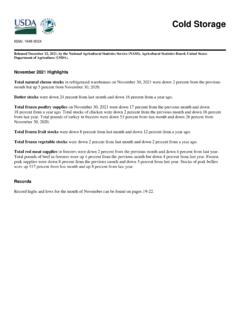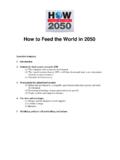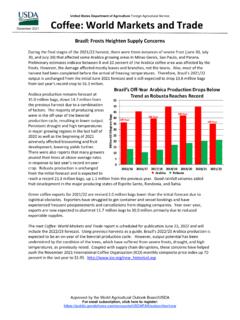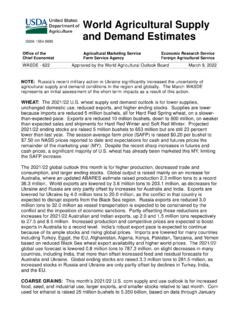Transcription of World Agricultural Supply and Demand Estimates
1 World Agricultural Supply ISSN: 1554-9089. and Demand Estimates Office of the Agricultural Marketing Service Economic Research Service Chief Economist Farm Service Agency Foreign Agricultural Service WASDE - 621 Approved by the World Agricultural Outlook Board February 9, 2022. WHEAT: The outlook for 2021/22 wheat this month is for stable supplies, lower domestic use, reduced exports, and higher ending stocks. Food use is lowered 3 million bushels to 959 million with durum accounting for the entire reduction. This is primarily based on the latest NASS Flour Milling Products report. Seed use is revised downward 2. million bushels to 64 million on the incorporation of NASS seed use data for the first two quarters of the marketing year. Seed use is also revised for the previous two years with updated NASS data. Exports are lowered 15 million bushels to 810 million on slowing export sales and shipments with reductions for Hard Red Winter and White. Projected 2021/22 ending stocks are raised 20 million bushels to 648 million but are still 23 percent lower than last year.
2 The projected season-average farm price (SAFP) is raised $ per bushel to $ on NASS prices reported to date and expectations for cash and futures prices for the remainder of 2021/22. This would be the highest SAFP since 2012/13. The global wheat outlook for 2021/22 is for lower supplies, higher consumption, increased trade, and reduced ending stocks. Supplies are projected falling by million tons to 1, million as reduced production more than offsets higher beginning stocks. The majority of production decreases are in the Middle East, where both Iraq and Syria are reduced due to the prolonged dry conditions. Projected 2021/22 World consumption is raised million tons to million on higher feed and residual use more than offsetting lower food, seed, and industrial use. The largest feed and residual use changes are for Canada and China. Canada is raised million to million as the Statistics Canada December 31 stocks report indicated greater August-December disappearance than previously expected.
3 China is lowered million tons to million as domestic wheat prices are no longer at a discount to corn and wheat auctions have not been as active this year. Projected 2021/22 global trade is raised million tons to million, primarily on higher exports by India and Argentina. India's exports are increased to million tons, which would be a record - exceeding 2012/13 exports. India's export pace continues to be robust, and its prices are competitive in Asian markets. Argentina's exports are raised million tons to a record million on an early strong pace. Projected 2021/22 World ending stocks are lowered million tons to million with reductions for Canada and India partially offset by increases by the United States and Ukraine. Global stocks are now projected at a 5-year low. WASDE-621-2. COARSE GRAINS: This month's 2021/22 corn Supply and use is unchanged relative to last month. The season-average farm price remains at $ per bushel. Global coarse grain production for 2021/22 is projected million tons lower to 1, million.
4 This month's foreign coarse grain outlook is for lower production and consumption, and smaller ending stocks relative to last month. Foreign corn production is lower, mostly reflecting declines for Brazil and Paraguay that are partially offset by an increase for the Philippines. Brazil corn production is reduced based on lower yield expectations for first crop corn. Paraguay corn production is down as extreme heat and dryness sharply reduce yield prospects. Foreign barley production is reduced reflecting declines for Iraq and Syria. Major global coarse grain trade changes for 2021/22 include lower corn exports for Paraguay. For 2020/21, Argentina and Brazil's exports for the marketing year beginning in March 2021 are raised based on observed shipments to date. For 2021/22, corn imports are raised for Iran and Canada. Barley exports are increased for the EU, with higher imports projected for China but lowered for Saudi Arabia. Foreign corn ending stocks are down, mostly reflecting a forecast reduction for Brazil that is partly offset by an increase for Argentina.
5 Global corn stocks, at million tons, are down million. RICE: This month's outlook for 2021/22 rice is for smaller supplies, unchanged domestic use, lower exports, and higher ending stocks. Total imports are lowered million cwt to million on reduced imports of medium- and short-grain rice. Medium- and short- grain imports are now forecast at million cwt, down primarily because of the timing of Puerto Rico imports this marketing year (MY). Exports of medium- and short grain- rice are lowered million cwt to million, as higher prices are expected to continue affecting sales for the remainder of the MY. Long grain exports are unchanged at million cwt. Projected 2021/22 all rice ending stocks are increased million cwt to million but still down 23 percent from last year. The season- average farm price for all rice is forecast at $ per cwt, up 60 cents per cwt on higher reported cash prices through December and expectations regarding prices for the remainder of the MY. Global 2021/22 rice supplies are increased by million tons to million, as higher production in Pakistan and Bangladesh more than offsets a decrease in Brazil.
6 Total trade in 2021/22 increases million tons to million, mostly on higher exports by India. In the first three months of its MY, India's rice exports were larger than a year earlier and Demand for Indian rice remains strong, including increased shipments of broken rice. India's exports are raised million tons to million, slightly below last year's record. Exports from Pakistan are forecast million tons higher to million because of larger production . World ending stocks are projected up slightly at million, and just below last year's record, with China holding 61 percent of global stocks. OILSEEDS: This month's 2021/22 soybean outlook is for increased soybean crush and lower ending stocks. Soybean crush is forecast at billion bushels, up 25. million from last month on favorable crush margins and improving prospects for soybean meal exports. Soybean meal exports are reduced for Argentina, Brazil, and Paraguay as WASDE-621-3. drought-reduced crops limit crush prospects.
7 With soybean exports unchanged, ending stocks are reduced 25 million bushels to 325 million. The season-average soybean price for 2021/22 is forecast at $ per bushel, up 40 cents from last month partly reflecting the impact of drought in South America. The soybean meal price is forecast at $ per short ton, up 35 dollars. The soybean oil price forecast is raised 1 cent to cents per pound. Global 2021/22 soybean Supply and Demand forecasts include lower production , crush, exports, and stocks. Global soybean production is reduced million tons to million on drought in South America. Brazil's soybean crop is lowered 5 million tons to 134 million, Paraguay is lowered million to million, and Argentina is reduced million to 45 million. Exports and crush are lowered in all three countries. Lower supplies and higher prices reduce global meal Demand , particularly for China where soybean crush and imports are lowered 3 million tons to 94 and 97 million, respectively. Global soybean ending stocks are reduced million tons to million.
8 Another notable oilseed change includes a increase to million for Indian rapeseed production on a faster-than-expected planting pace and higher yields. SUGAR: The sugar Supply for 2021/22 is increased 45,434 short tons, raw value (STRV) as an increase in cane sugar production is only minimally offset by a reduction in imports. Louisiana cane sugar production for 2021/22 is increased by 49,170 STRV to 1,905,741 on industry reporting. The sugarcane harvest ran longer through January than normal and the crop had strong sucrose content. Raw sugar imports entering under the 2020/21 TRQ that had been extended to December 31 are adjusted down 3,736 STRV by Customs and Border Protection. There is no change to sugar use this month. Ending stocks are increased by the amount of increased Supply to 1,818,472 STRV for a stocks-to-use ratio of percent. There are only small changes for the 2021/22 Mexico Supply and use. Imports for consumption are reduced by 9,000 metric tons (MT) due to lower domestic prices.
9 Deliveries to the IMMEX program are increased by 11,057 MT to 497,000 on greater pace-to-date deliveries. Ending stocks are up slightly and residually determined exports, other than those to the United States under the AD/CVD Suspension Agreements, are reduced by 22,360 MT. LIVESTOCK, POULTRY, AND DAIRY: Estimates of 2021 red meat, poultry, and egg production are adjusted to reflect December production data. The 2022 forecast for total red meat and poultry production is lowered slightly from last month, as higher forecast beef production is more than offset by lower pork, broiler, and turkey production . The beef production forecast is raised from the previous month as larger expected placements during first-half 2022 are marketed in the latter half of the year. However, the increase in fed cattle slaughter is partly offset by lower non-fed cattle slaughter. Pork production is lowered on a slower pace of slaughter. Broiler and turkey production forecasts are reduced on current hatchery data and higher expected feed costs.
10 The egg production forecast is reduced from last month as higher feed costs are expected to temper production growth. WASDE-621-4. Livestock, poultry, and egg trade Estimates for 2021 are adjusted to reflect December trade data. For 2022, the beef import forecast is raised on strong Demand for processing beef; the export forecast is unchanged. Pork exports are reduced on continued weakness in Demand from China and increased competition in other markets. The broiler export forecast is lowered on weaker Demand from a number of Asian markets. The turkey export forecast is reduced from last month on slower Demand . Fed-cattle prices are raised for the second half of the year on firm packer Demand . Hog, broiler, turkey, and egg price forecasts are raised on current prices and slower growth of production expected during the year. Egg prices are also raised on current prices and slower production growth. The 2021 milk production , trade, and stock Estimates are adjusted to reflect December data.
